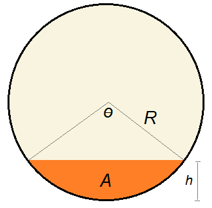
| Rotor-Equivalent Wind Speed Calculated Column |  |
Wind turbine power curves have traditionally reported power output versus hub height wind speed. But because the wind speed can vary significantly over the diameter of a modern wind turbine rotor, some have suggested that the hub height wind speed no longer provides an accurate indication of the wind conditions faced by the turbine. The rotor-equivalent wind speed (REWS) has emerged as one way to take into account the varying speeds across the diameter of the rotor. Windographer lets you define a calculated column containing the REWS.
Windographer calculates the REWS as the area-weighted average of the wind speeds in several vertical slices across the swept area of the rotor. The image below shows a rotor with diameter D and hub height Zhub, divided into five vertical slices with areas A1 through A5:

Windographer can calculate the REWS as a simple mean, weighted only by the area of the slice:

Or as a cube root mean cube, again weighted by area:

where: | ||
| N | is the number of horizontal slices | |
| Ui | is the mean wind speed of the ith slice | |
| Ai | is the area of the ith slice | |
| A | is the swept area of the rotor |
To calculate the area of each vertical slice of the rotor disk, Windographer uses the equation for area of a circular segment:


where R is the rotor diameter, h is the height above the bottom of the circle, and the angle q is given by the following equation:

You can specify as many vertical slices as you wish, but your dataset must contain a wind speed sensor at the center height of each slice. Use the Vertical Extrapolation window if necessary to synthesize speed data at the required heights.
Windographer will calculate the REWS only in time steps that contain a valid wind speed for every slice height. If one or more speed values are missing or flagged to exclude from calculations, Windographer will not calculate the REWS so the calculated column will appear as a gap in that time step. Default flag filtering applies.
Whenever you change any of the wind speed data columns, for example by flagging or deleting a segment, applying a scale factor, adjusting calibration, or appending more data, Windographer will re-calculate the REWS data column and any other calculated columns that depends on the modified data column.
See also